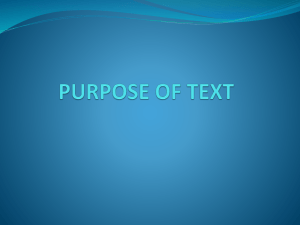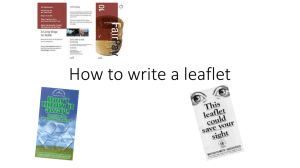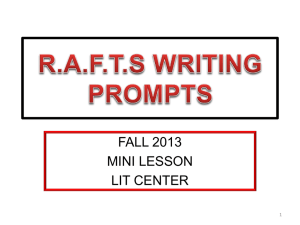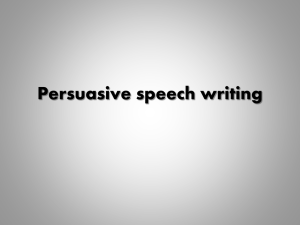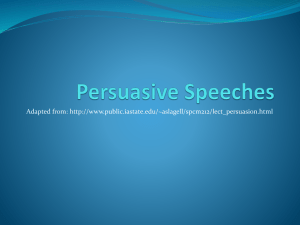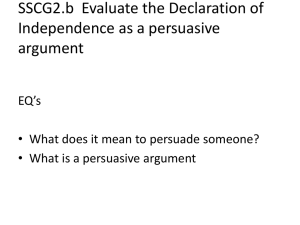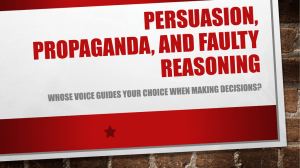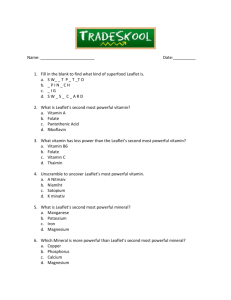persuasive text leaflet
advertisement
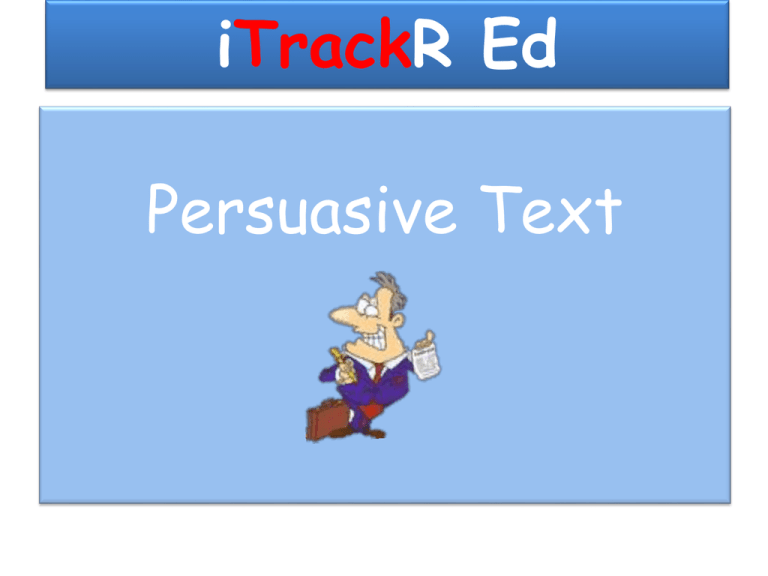
iTrackR Ed Persuasive Text Writing persuasive text Section One Objectives: Reading: To recognise when text is fit for purpose Writing: To identify the different purposes of text and To understand how the purpose of text affects content and use of language Task: Create a persuasive leaflet Identify different types of persuasive text. When you write, you need to ask yourself these questions. “Why am I writing? What is my aim?” This is YOUR PURPOSE Clueless! “Who am I writing to? Who is going to read it?” This is YOUR AUDIENCE Purpose The assessment question will always state what the purpose of the piece of writing is, for example: Write a leaflet for teenagers in which you persuade them the benefits of not smoking. Write a leaflet for parents in which you persuade them about the benefits of school meals for their children. The purpose is key to your writing. It is essential that your final piece of writing suits its purpose from beginning to end. Audience Let’s look at the features of different types of persuasive writing… Before you begin any piece of writing you should consider the audience you are writing for. Can you identify the type of audience the following images are aimed or targeted? What’s the point ..? Persuasive texts are designed to persuade people or to convince people of a point of view. Good persuasive texts tempt the reader. Where to start ..? Draw the audience in by making a bold statement. Address the main issue and state your position. Connect ..! Use complex sentences linked with connectives that explain your views: however, therefore, because, although, yet etc. Did you know ..? Ask rhetorical questions, eg ‘...Bet you didn’t know that ..!’ It’s a known fact ..! Try to make opinions sound like fact, ‘We all know that it’s the best thing since ...’ End it ...! Conclude by summarising your key points. Beware of imitations! Get the real deal! Analysing leaflets In pairs, look at the leaflets provided. Discuss and complete the grid on each leaflet. Topic of leaflet Fire safety in the home Text type Advice/ information Evidence Should Must Diagrams Audience Adults Evidence Formal language, “it is recommended” Structuring ideas An effective plan should organise your ideas into a sensible order that allows your writing to flow and where one idea moves logically onto the next one. Using the planning list and frame for a leaflet can be very helpful: Let’s start with the planning list .... Planning list My leaflet is about .. The purpose is to ... The audience will be ... The slogan is ... The facts about my topic that I intend to use in my leaflet are: • I will use the following images: • Ideas for my case study • Ideas for the layout (including size, colour, font and graphics • • • • • Go to www.jamieoliver.com and click on “school dinners” for further information and facts. Jamie’s the main reason schools around the country are now ‘healthy’ schools. In fact, he was so persuasive, that the Government passed laws to support his campaign... Writing frame for a persuasive leaflet • • • • • • • • • • Slogan/logo Introduction – main points Image Caption Facts about the topic – background Appeal Image Directions – what the reader should do Image Contact details/reply slip Go to www.ash.org.uk and click on “young people and smoking” for further information and facts. Mistakes to avoid ...... Remember to have well developed paragraphs to enable you to convey your writing ability to the reader, in this case me (the examiner). Don’t forget to plan out the key areas you intend to cover. Look carefully at the target audience you are writing for and adapt your writing accordingly. Miss Marks The Examiner Plan and draft writing Wt/L1.1 Present information in a logical sequence, using paragraphs where appropriate Wt/L1.3 Use format and structure for different purposes Wt/L1.5 Use language suitable for purpose and audience Wt/L1.4 Writing to Persuade Task 1: Plan and draft your writing using the ‘writing/planning frame for a persuasive leaflet’. Task 2: A: Write a leaflet for parents in which you persuade them about the benefits of school meals for their children. OR B: Write a leaflet for teenagers in which you persuade and inform them the dangers of smoking. Plenary & Self Assessment Review learning objectives: Reading: Were you able to identify when to apply persuasive text? Writing: Were you able to apply the persuasive language effectively to your target audience? Did you reflect this in your self assessment? Peer Assessment Look back through the writing. Write a list of all the things you thought your partner did really well. Include things linked to the objectives, but also include things that were not. Write a list of everything s/he did right. Give examples. On Your Post-It Two Stars & A Wish Something new you have learnt? Something you enjoyed in the lesson? What were you unsure of in the lesson?
